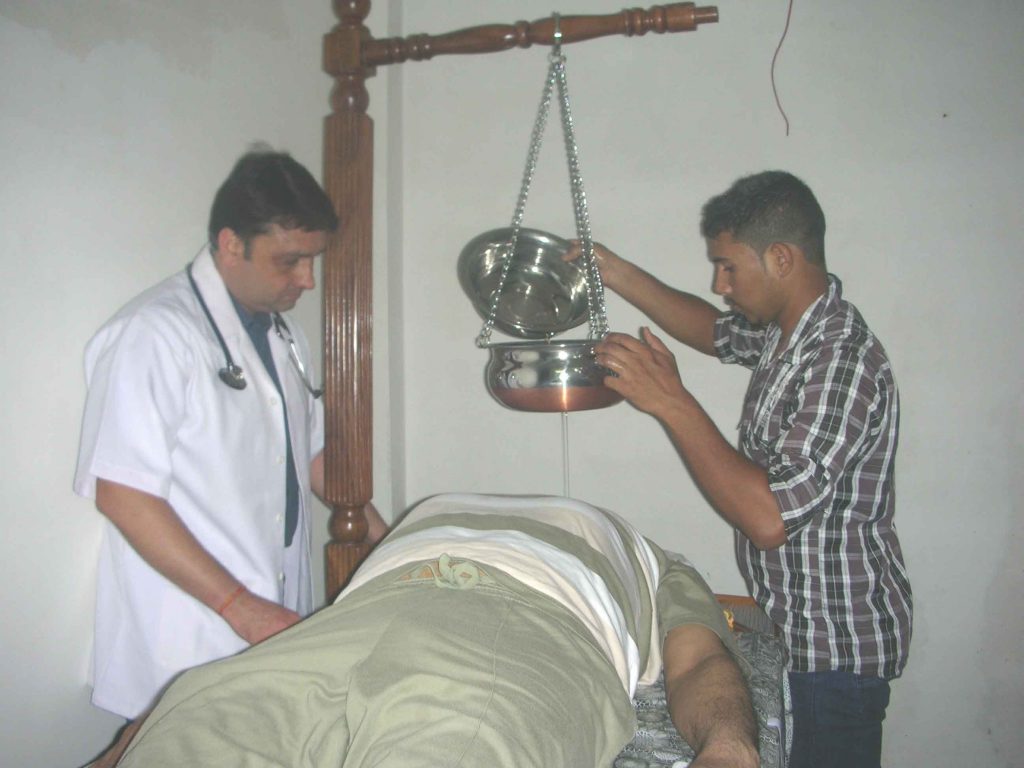
The treatment in Ayurveda consists of four basic forms :
A) Medicine or drug therapy
B) Pancha (five) karma (actions/systems)
C) Dietary regime
D) Lifestyle regulation
Ayurveda works in two fundamental ways :
A) Curative : Consists of internal medicine
B) Prevention : Personal hygiene, daily routine, seasonal corrections and appropriate behavior.
Ayurveda emphasizes preventative and healing therapies along with various methods of purification and rejuvenation. Ayurveda is more than a mere healing system; it is a science and an art of appropriate living, which helps to achieve longevity. Panchakarma is Ayurveda’s primary purification and detoxification treatment. Panchakarma means the “five therapies”. It is a comprehensive system of knowledge and practices to purify the body of toxins and restore it to balance with natural law. These five therapeutic means of eliminating toxins from the body are Vamana, Virechana, Nasya, Basti and Raktamoskshana. This series of five therapies help remove deep-rooted stress and illness causing toxins from the body while balancing the doshas (energies that govern all biological functions). Panchakarma is ineffective if special detoxification diet is not given along with the treatments. Panchakarma plays a vital role in Ayurvedic medicine, both in health as well as in disease. Although panchakarma is often thought of as the entire procedure, it really is only one part of a group of therapies belonging to a class of cleansing procedures called shodan. There is also a group of milder techniques called shaman for those not strong enough for shodan.
In today’s world when more and more people are falling prey to the adverse effects of stress and anxiety, which is leading to diseases like improper digestion, lack of sleep, allergies, chronic fatigue, cancer, heart diseases, diabetes, osteoporosis etc. The importance of pancha karma in ayurveda is borne out by the fact that it is applicable to all cases covering a wide range of preventive, curative, and promotive conditions. These diseases are caused mainly due to deeply seated toxins. With the process of Panchakarma it eliminates these toxins from the body, allowing healing permanently of tissues, channels, digestion and mental functions. In Ayurveda, the treatment is broadly divided into two categories: Shodhana and Shamana. Curing the disease by cleaning out the impurities is called Shodhana chikitsa, which is the principle of Panchakarma. It involves the clearing of vitiated doshas (vata, pitta and kapha) which cause the disease and thereby the restoration of equilibrium of doshas.
The main emphasize of Ayurveda is on preventative and healing therapies along with the various methods of purification and rejuvenation
Panchakarma includes Five Basic Cleansing Methods, purification therapies (Shodhans):-
Panchakarma is a form of treatment in Ayurveda where treatment is done by using various procedures like massage, steam, medicated enemas etc. The deep cleansing process, unique to Ayurveda, that enables the body to release excess doshas and toxins from its cells and expel them is called Panchakarma, which basically denotes detoxification or elimination of toxins from the body. Although the human body is considered as a great, intelligent, natural healing system capable of rejuvenating itself, the formation of toxins reduces that natural capacity. It is then that Panchakarma plays a crucial role in that correction.
According to Ayurveda a balanced state of body, mind and consciousness is important to remain healthy. To achieve this balance Ayurveda recommends the panchakarma therapy.
Panchakarma is a Sanskrit word where pancha means five and karma refers to the therapeutic measures. Thus, panchakarma means five types of therapeutic measures. The panchakarma therapy of Ayurveda comprises of five basic types of advanced treatment to eliminate toxic matter from the body. It is part of a group of therapies belonging to a class of cleansing procedures known as shodan.
Medicated puking (vamana) to remove excess kapha
Therapeutic purgation (viracana) to clear excess pitta
Medicated clyster, enema ,(vasti) to eject excess vata
Nasal drops or snuffs (nasya) for diseases of the head & neck
Bloodletting (raktamokshana) in case of blood disorders
Panchakarma includes three main parts namely :
Poorva Karma (Preparatory Methods) which includes :
Paachan (Digestion)
Snehan (Internal and external oleation)
Swedan (Fomentation)
Pradhan Karma (Main methods) which includes :
Vaman (Induced vomiting)
Virechan (Induced purgation)
Basti (Medicated enema)
Nasya (Nasal medicine)
Rakta Mokshan (Artificial bloodletting)
Pashchat Karma (Post-Therapeutic Measures) which includes :
This includes Sansarjan Krama (Specific dietetics), DhumaPana (smoking of medicinal cigars) and some rules to follow specific activities
Panchakarma is a very special Ayurvedic operation requiring proper guidance from a highly trained and skillful Ayurvedic practitioner. This should not be undertaken just from information in this article. One should consult with an Ayurvedic physician, not just someone with a modest amount of training. Panchakarma is done individually for each person with their specific constitution and specific disorder in mind, thus it requires close observation and supervision. It is also done to best advantage, although not always, at the junctional period between two seasons, thus helping a person to prepare their internal environment for the oncoming season.
